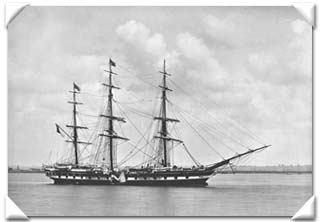
Immigrant shipping
Immigrant Ships
This is not intended as a listing of all of the ships that brought immigrants to South Australia; there are many books and resources that can provide that information, some of which are listed in the 'further reading' that concludes this section. Rather it is intended to provide an idea of the types of ships that carried the migrants, the conditions they lived under aboard ship, and touching upon briefly, first impressions on arrival. There are a number of distinct periods of the major migration movements to South Australia: the era of the sailing ship from 1836 to the 1860s; the late 19th century and the early steamships; early 20th century; and post World War II.
The sailing ship era
The very first immigrant ships took four to six months to make the long voyage to South Australia. The passengers were fortunate in that they did not need to face the dangers of the southern coastline or of Bass Strait, which are notorious for the number of shipwrecks along the shores; their first sight of their new country was Kangaroo Island, as it would be for so many later ships. Indeed the very first ships sent out by the South Australian Company had been directed to Nepean Bay on Kangaroo Island.
The majority of ships bringing immigrants to South Australia would have no return cargo for the voyage back to Britain - at least not for many years. They would need to find it elsewhere in Australia, Sydney for example, and travel in ballast to do so. Many sailed to Mauritius to take on a cargo of sugar. For the shipowner the long voyage needed to be profitable both ways: the ship would be away from its home port for 12 months or more.
The average size of the early ships was 450 tons - they could be considerably smaller, and sometimes larger. At this time they were wooden vessels, barque or ship rigged. There was some cabin accommodation for private emigrants who could afford the additional privacy and relative comfort, but the vast majority of emigrants travelled in steerage. The conditions are almost unimaginable today.
The British Passenger Acts before 1847 gave these people little protection from unscrupulous captains and the ship owners. Subsequent legislation provided theoretical protection and a certain level of accommodation and food, but there was always the opportunity for the determined to take advantage of the passengers: they had no alternative place to go after all. In addition to the passengers, the ships carried their goods and although this was limited to 20 cubic feet of free luggage space which went into the ship's hold, they kept with them in their berths a month's necessities of clothing and their eating utensils.
The crowded deck provided little room for movement with the boats, ropes and hatch covers essential for the ship's working; and then there was the livestock and their fodder. Living conditions for steerage passengers were dark and congested: berths were made of timber, two-tiered with a narrow space beneath for storing boxes. There was no privacy other than a partition separating the single men from the families and at the opposite end the single women. A long wooden bench with fixed seating ran down the centre - here all meals were served, and any tasks carried out. Ventilation was difficult in these early ships, as the hatches could only be opened in good weather. In anything other than good weather the hatches were kept sealed to prevent water getting below decks. Lighting was also a problem: oil lamps were used only between certain hours and were very carefully tended: they were in a wooden ship and the risk of fire were high. Coupled with the cramped, ill-lit and poorly ventilated accommodation for the steerage passengers were the lack of fresh drinking water, of food and its preparation, and availability toilet and washing facilities. All of these left much to be desired by today's standards.
In the days before refrigeration and quality canned foods, the basics of shipboard diet were salt meats (beef and pork), bread, pease (lentils and other legumes) and oatmeal. There was little in the way of fresh food. All food was cooked at a common galley: getting the food safely down to the passenger quarters was a task in itself, particularly if the weather was rough. Fresh water was for drinking only; for personal hygiene and washing a bucket of seawater was drawn up from the ocean.
For the women and children in steerage an enclosed water closet was provided for toileting - generally flushed by a bucket of sea water or from a manually operated tank of seawater. Conditions during the early days of the voyage, coping with sea sickness, must have been difficult. The men used the ship's heads (generally the bow of the ship and on the lee (or sheltered) side of the ship: exposed and unsafe in rough weather).
Shipboard health was another issue for the passengers to cope with: generally there was a surgeon aboard, but the care he was able to provide was often very limited, particularly if there was a shipboard epidemic: there were few remedies for the common diseases of the 19th century, and very little opportunity to place a patient in isolation. Measles aboard ship was deadly and the cause of many deaths among the children; cholera, typhoid and dysentery could be brought aboard through tainted water and the disease proliferated in the crowded conditions. Childbirth was yet another problem, and one that posed the greatest risk for both mother and child; there was no midwife employed aboard ship, and the surgeon would be consulted only as a last resort. Other women would assist as they could in the delivery, for which the only privacy would be a blanket screen. The odds of the child surviving the voyage were 50-50; infantile deaths were accepted very much as the norm.
Items 13 - 24 of 24













